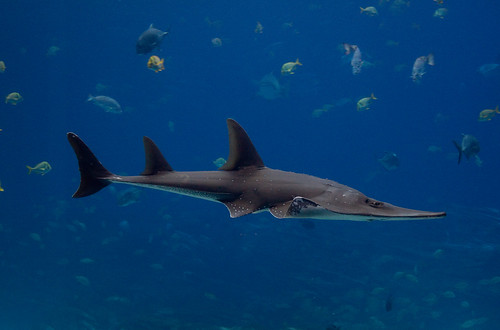一份全球性鯊魚、魟魚和相近物種的保育狀況報告指出,全球1/4以上的鯊魚和魟魚物種有滅絕危機。研究指出,過度捕撈是這些物種最大的威脅。
這份報告由世界自然保育聯盟IUCN鯊魚專家小組來自64國的302位專家合作撰寫,針對1041種鯊魚、魟魚以及相近物種進行保育狀況調查,以編列第50屆IUCN紅色名錄。
淺海意外捕撈 軟骨魚成食材藥材
IUCN鯊魚專家小組共同主席、加拿大西門菲沙大學研究主席Nick Dulvy博士:「我們的分析顯示,鯊魚和其近緣物種的滅絕風險急遽升高。體型最大的鯊魚和魟魚情況最危急,尤其是棲息在淺海、容易被捕捉到的物種。」意外捕撈到的鯊魚和魟魚佔捕撈總數的比例很高,不過由於市場需求升高、目標漁獲越來越少,這樣的「意外」也越來越受歡迎。
印度洋─太平洋海域,特別是暹羅灣和地中海,鯊魚和魟魚數量減少的速度最快。專家指出,紅海是許多受威脅鯊魚和魟魚的棲息地。研究作者寫道,「鯊魚、魟魚和銀鮫的滅絕風險比其他種群都要高,列入安全範圍的物種比例最低──只有23%被列為無危保護等級。」
除了鯊魚和魟魚外,報告所調查的1041種軟骨魚類還包括銀鮫,以及居住在海平面650英尺以下的軟骨魚類。這些軟骨魚類的骨骼由軟骨構成,因此常常成為食物或藥材的原料。
捕撈量魟魚多於鯊魚 保育進度緩慢
「全球的魚翅市場不只導致鯊魚數量減少,連魟魚也遭殃;某些魟魚的鰭價格相當昂貴,如犁頭鰩。」科學家說。鯊魚、魟魚和銀鮫不但常被當成食材,深海鯊魚的肝也常被製成藥物,蝠鱝和魔鬼魚則被用做補身的中藥。
研究指出,鯊魚、魟魚和銀鮫的官方統計捕撈數量最高峰是在2003年,但是作者警告,實際上的捕撈數量很可能遠不止於此。專家計算出過去40年,官方統計捕撈數量最多的是魟魚。
「我們很驚訝地發現魟魚,包括鰩、犁頭鰩、赤魟和鱝,保育情況甚至比鯊魚還糟糕,最受威脅的物種中有5/7是魟類。」IUCN鯊魚專家小組共同主席、澳洲詹姆斯庫克大學環境科學教授Colin Simpfendorfer說。
「鯊魚日漸受到公眾、媒體和政府的重視,但是魟魚數量的大幅減少卻少有人注意。而且魟魚保育措施進度緩慢,我們不得不對這個物種抱持嚴正關切。」
At least one in every four existing species of sharks and rays may not survive into the future, finds the first global analysis of the conservation status of 1,041 shark, ray and related species.
This study, conducted by the IUCN Shark Specialist Group, marks the 50th anniversary year of The IUCN Red List.
“Our analysis shows that sharks and their relatives are facing an alarmingly elevated risk of extinction,” said Dr. Nick Dulvy, IUCN Shark Specialist Group Co-Chair and Canada Research Chair at Simon Fraser University in British Columbia.
“In greatest peril are the largest species of rays and sharks, especially those living in shallow water that is accessible to fisheries,” he said.
Overfishing is the main threat to the species, finds the study, the product of 302 experts from 64 countries.
The Indo-Pacific, particularly the Gulf of Thailand and the Mediterranean Sea are the two spots where the depletion of sharks and rays is most dramatic. Also, the Red Sea is inhabited by many threatened sharks and rays, according to the experts.
The 1,041 cartilagenous fish species studied include sharks and rays as well as chimaeras, cartilaginous fish that live deeper than 650 feet below the surface.
The skeletons of these cartilagenous fish are made of cartilage rather than bone, making them desirable for food or pharmaceuticals.
“The global market for shark fins used in shark fin soup is a major factor in the depletion of not only sharks but also some rays with valuable fins, such as guitarfish,” the scientists say.
Sharks, rays and chimaeras are also sought for their meat, pharmaceuticals are made from deep sea shark livers, while manta and devil rays are used in a Chinese tonic.
The sharks, rays and chimaeras are at a “substantially higher risk than most other groups of animals and have the lowest percentage of species considered safe – with only 23 percent categorized as Least Concern,” the authors state.
The study finds that reported catches of sharks, rays and chimaeras peaked in 2003, but the authors warn that actual catches “are likely to be grossly under-reported.”
Reported catches have been dominated by rays for the last 40 years, the experts calculated.
“Surprisingly, we have found that the rays, including sawfish, guitarfish, stingrays, and wedgefish, are generally worse off than the sharks, with five out of the seven most threatened families made up of rays,” said Dr. Colin Simpfendorfer, IUCN Shark Specialist Group co-chair and professor of environmental science at James Cook University in Queensland, Australia.
Unintentionally caught sharks and rays account for much of those killed, yet developing markets and depleting fishery targets have made this “bycatch” increasingly welcome.
“While public, media and government attention to the plight of sharks is growing, the widespread depletion of rays is largely unnoticed,” said Simpfendorfer. “Conservation action for rays is lagging far behind, which only heightens our concern for this species group.”
※ 全文及圖片詳見:ENS

